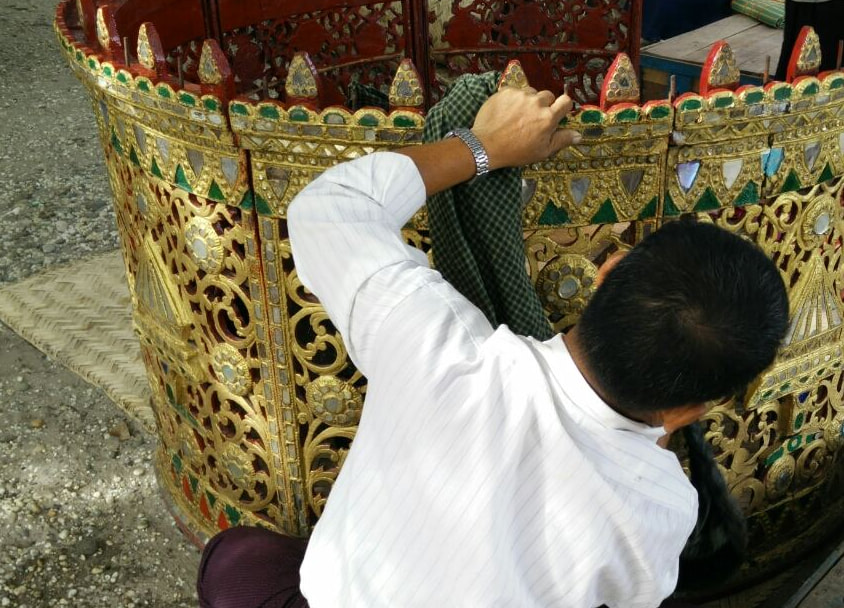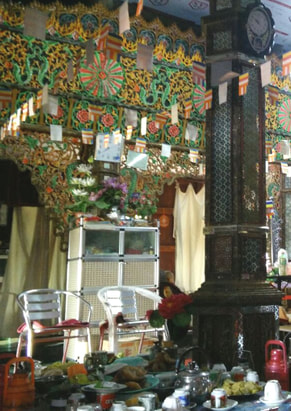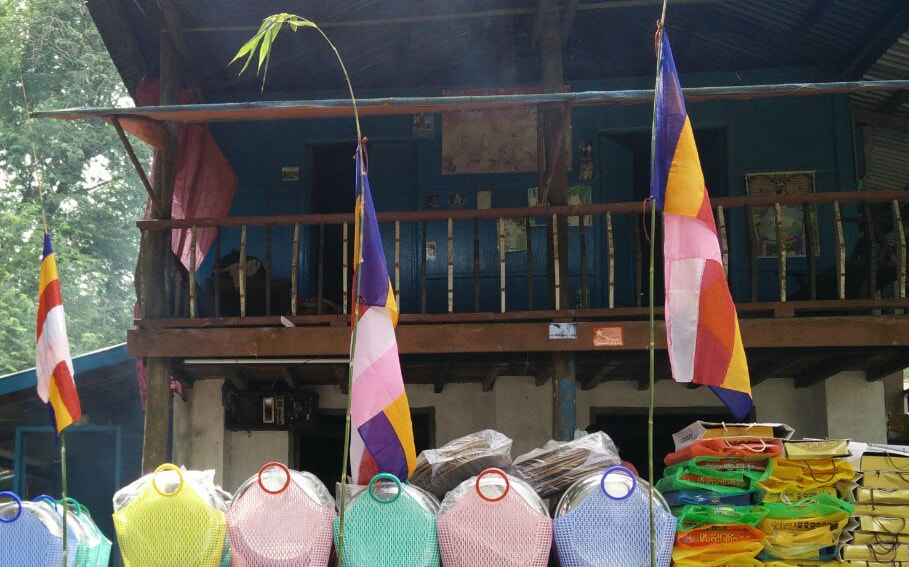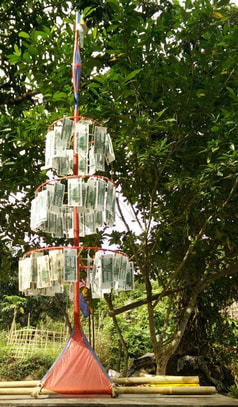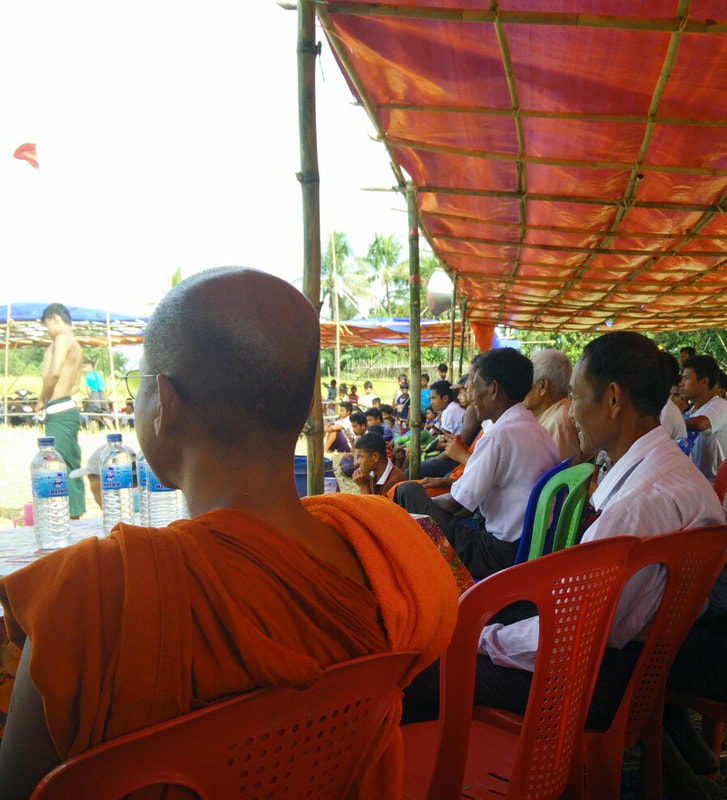|
It took 17 hours. We left Yangon at 5:30 pm when the traffic was heavy and the light was dimming. The traffic was not the only heavy thing as the head monk of the monastery where I have been teaching cranked up the radio to what sounded a lot like Burmese metal music! It was somewhat surreal to be in a Toyota pick-up with the head monk, heavy metal blaring out of the sound system and another new monk in the back. I must admit I did somewhat forget about the monk when it got too dark to see him, and it was quite a surprise when he jumped out of the back at 10 pm when we stopped for food! I had arrived at the monastery a bit too early in the day really, not quite knowing the expected timings. This meant that I got to see one of my ex-weekend students who looked after me for the day. It was nice to see him again, although he hasn’t had time to implement any teaching methodology as he is hard at work preparing for his final exam at the end of November. The journey was on the whole, unremarkable apart from it’s length. Most of the leg-work was done under the cover of darkness and I tried to sleep as much as possible. The head monk is certainly a back-seat driver, albeit from the passenger seat! The driving got more bumpy as we progressed into Rakhine state; with big parts being done off road at 10 mph! We visited the famous pagoda when we arrived in Kyauk Phyu. Van and I visited it on our August trip, so it was nice for me to be able to recognize some of the scenery after a whole lot of dark countryside en route. The monastery we are visiting is very small; just one main building with a few outhouses. Apparently, it only houses 3 monks. All of the monks look very old to me, and I suspect it may not be long until this monastery no longer has inhabitants. There is a bronze cast of a previous resident monk next to the 20 feet tall Buddha image which is in a hall adjacent to the main building. The main building is on stilts with two entrances and a large wooden hall. The supports are covered in colorful tiled mosaic and the intricate carvings around the top of the room are painted in lurid pinks, yellows and greens. The whole effect is incongruous with the simple countryside surrounding it. However, as I am learning more and more, people here love color in all shapes and forms. The reason for my invitation and the monk’s return to his hometown was a donation ceremony which happens every year at this time. The villagers were all busy chopping and cooking food for the festivities. We were gifted fresh coconuts to drink from and invited to the house of the sister to the local business man who has since made it big and comes back to share his generosity and wealth. On our first evening, there was a respect ceremony for the 23 old people who live in the village. The daughter of the business man gave each elderly person a crisp 10,000 Kyat note in a ritualistic bowing motion while keeping the traditional head-being-lower-to-show-respect position. The culmination of the donation was a long procession of villagers around the village and to the monastery, ending in the brightly colored room depositing clothing and accessories for the monks. The highlight for me was a money tree of 1,000 Kyat notes. It needed two men to carry it and had a very tall pole with a flag on top. This proved to be a real challenge for the two villagers tasked with transporting it safely to the monastery; they had to duck and dive under the roof and up the stairs, all the while taking care not to drop the treasured item. Fortunately they were in good spirits about it and I suspect that it is done every year, partly as a crowd pleaser. The women were all dressed in their finest colorful longyi sets while the men donned crisp shirts and new longyis. Older women were keen to dance and show me local traditional moves; I am afraid to say that I didn’t join in as right at that moment we were invited to the hall to observe a rice prayer ritual. I assume that this is a form of prayer for a good rice harvest in the next year. The Arakanese people certainly need a good harvest after the deviation wrought by the August cyclone and subsequent flooding. Early the next morning we returned to the monastery where there were many cars of monks who had travelled to receive the benefits of the donation ceremony. It is easy to tell which cars belong to monks and monasteries because they each have Myanmar script across the front windshield, which I believe to be the name of the monastery from which they're come. There was a traditional Arakanese band playing and the atmosphere was again that of a party. Part of the party is a wrestling competition, where competitors are pitted in age not height or weight categories, so you can sometimes have a relative monster with what looks like little more than a child! The donor business man and the head monk with whom I travelled watched the wrestling, with the businessman handing out new 1,000 Kyat notes to each competitor. I have to admit, my thought was: where will they put that seeing as they are practically naked, and what a waste of new money because they’re all sweaty from wrestling! Perhaps it is fair to say that I didn’t fully enter into the spirit of the wresting matches!
We have spent time on the beach with the daughter of the business man hunting for crabs, and eaten lots of tasty Arakanese food in local restaurants. It has been a great cultural experience for which I am very grateful to the head monk. Chloe Smith NEH Coordinator and Teacher Trainer
Comments
|
This section will not be visible in live published website. Below are your current settings: Current Number Of Columns are = 3 Expand Posts Area = 1 Gap/Space Between Posts = 20px Blog Post Style = card Use of custom card colors instead of default colors = Blog Post Card Background Color = current color Blog Post Card Shadow Color = current color Blog Post Card Border Color = current color Publish the website and visit your blog page to see the results |
|
© New Education Highway 2024
Except where otherwise noted, content on this site is licensed under a Creative Commons Attribution 4.0 International License. |

